Japan
Wood Products Prices
Dollar Exchange Rates of 10th
May 2017
Japan Yen 111.87
Reports From Japan
War on deflation gradually being won
According to the latest release from the Japanese
Economic and Social Research Institute in the Cabinet
Office, consumer confidence in Japan fell slightly in April
from a month earlier.
The survey revealed that the index reflecting consumer¡¯s
perception on prospects for improvement in overall
livelihood fell month on month as did the index for
prospects for income growth. However, consumers
considered that employment prospects were improving
but, in line with sentiment in the retail sector, the index for
willingness to buy durable goods fell almost 2% from
March.
Expectations that deflation can be beaten are at the core of
consumer sentiment on employment. Japan has struggled
with deflation for nearly 25 years, but may now be
reversing the downward spiral.
March employment data showed that unemployment stood
at 2.8%, a 22-year low. This, along with positive GDP
growth, is likely to give employers the confidence to raise
wages further. According to Morgan Stanley report
average hourly earnings could rise by over 3% in 2018.
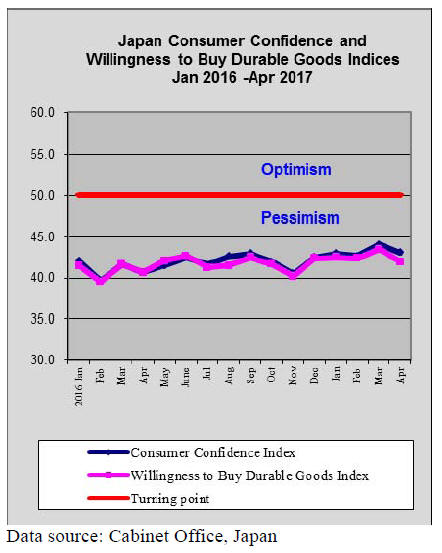
Post French election - yen weakens to delight of
exporters
The result of the French presidential election boosted the
euro, had a roll-on effect on the dollar and sank the yen
slightly. Both the euro and dollar advanced against the yen
by around 2% after the result of the poll in France. This
was welcome news in Japan as the yen had been
strengthening against the dollar, putting export growth at
risk.
Analysts are forecasting further dollar strength
anticipating interest rates in the US will be lifted higher,
possibly as soon as June.
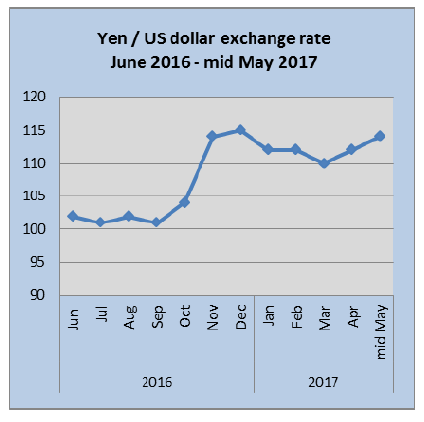
A use for abandoned homes
The Japanese government has added clauses to exiting
legislation creating a system whereby regional
governments will register vacant properties with a view to
renovated those of suitable condition for letting to lowincome
families who cannot secure other public housing.
The current Safety Net Law is there to protect seniors
living alone, low-income families, disabled persons and, in
the event of disasters, displaced households. Such people
are eligible for public housing but not enough is available.
The revised law should result in an expansion in the stock
of homes and at the same time begin to address the
problem of abandoned houses.
See: http://www.japantimes.co.jp/community/2017/04/30/howtos/
safety-net-law-offer-new-lease-life-abandonedbuildings/#.
WRUGOV-GPIU
Import round up
Doors
Japan¡¯s March 2017 wooden door imports returned back
to levels seen in December 2016, snapping the downward
trend that began in January this year. March imports were
up 35% month on month but were down 2% compared
levels seen in March 2016.
On a quarterly basis, 2017 wooden door imports were
down 19.5% from a year earlier.
The top suppliers in March, in order of rank, were China
(49%), Indonesia (9%) and Vietnam (9%) accounting for
81% of Japan¡¯s wooden door imports for the month.
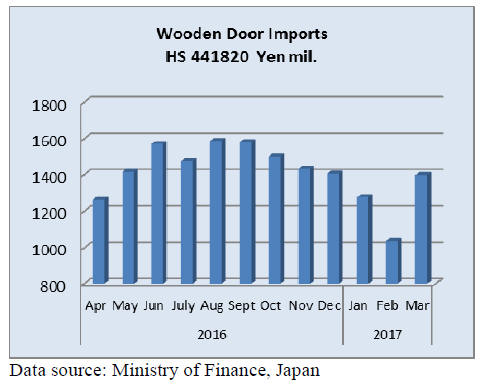
Windows
Year on year, the value of Japan¡¯s March wooden window
(HS441810) imports were up 10% but compared to
February import values fell slightly. First quarter 2017
wooden window import values were down 13% from the
same period in 2016.
In March this year three shippers accounted for over 85%
of the value of wooden window imports, China (49%),
USA (30%) and Sweden (8%).
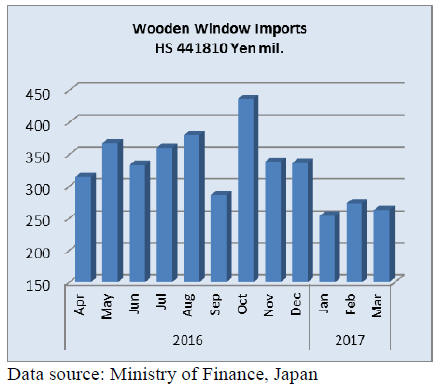
Assembled flooring
Following the massive correction in the value of Japan¡¯s
imports of assembled flooring in February this year there
was a rebound in March. March 2017 imports of
assembled flooring (HS441871-79) rose around 50% from
a month earlier.
Since September 2016 the value of assembled flooring
imports ha drisen every month until the correction in
February. The March 2017 import values are just below
levels reported in December 2016.
Year on year, March 2017 assembled flooring imports are
up 41% and first quarter 2017 assembled flooring imports
are up 22% compared to the first quarter in 2016.
One category of assembled flooring, HS441879, accounts
for most imports to Japan and within this category three
shippers, China, Thailand and Indonesia, accounted for
over 90% of Japan¡¯s imports in March 2017.
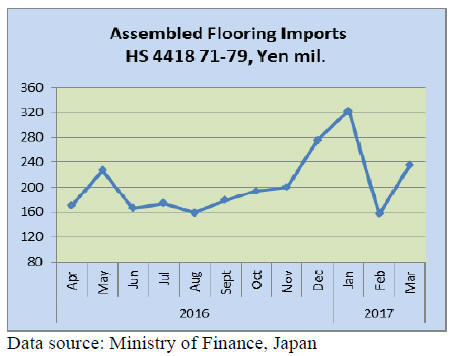
Plywood
The figure below shows the trend in imports of plywood (
HS 441210/31/32 and 39). Throughout 2016, as was the
case in 2015, almost 90% of Japan¡¯s plywood imports are
from Malaysia, Indonesia and China. This trend continued
into March this year. Most of Japan¡¯s plywood imports are
within HS 441231 (87%).
Year on year March shipments of plywood from the top
supplier, Malaysia, rose 18% with Indonesia seeing a
19.5% increase while imports from China, the third ranked
supplier, recorded a 44% year on year rise.
First quarter 2017 plywood import volumes were up 12%
compared to the first quarter in 2016. Imports from
Malaysia were up 20%, imports from Indonesia rose a
modest 2% while imports from Chian were flat.
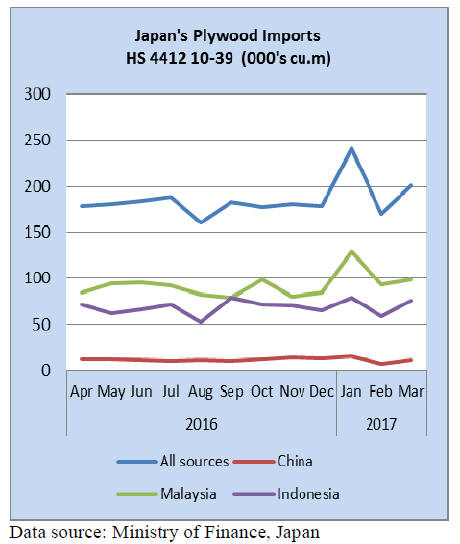
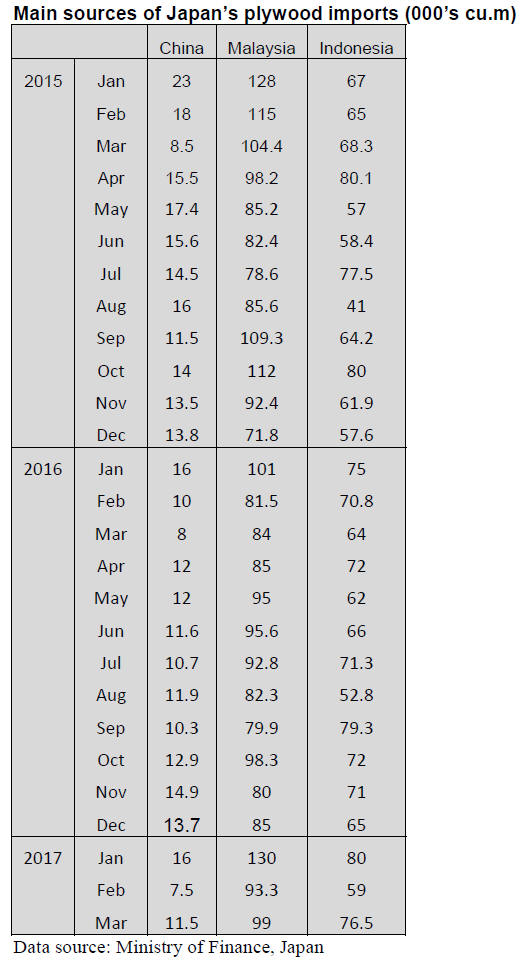
¡¡
Trade news from the Japan Lumber Reports (JLR)
For the JLR report please see:
http://www.nmokuzai.
com/modules/general/index.php?id=7
Wood statistics for 2016
The Ministry of Agriculture, Forestry and Fisheries
announced wood statistics of 2016. According to that,
demand for logs was 26,029,000 cbms, 3.7% more than
2015. In log supply, domestic logs were 20,660,000 cbms,
3.0% more than 2015 and imported logs were 5,370,000
cbms, 6.4% more. Share of domestic logs was 79.4%, 0.5
points less.
By use, log supply for lumber was 16,590,000 cbms, 2.5%
more, for plywood was 4,638,000 cbms, 10.0% more and
for wood chip was 4,801,000cbms, 2.3% more. This tells
active demand for plywood, which was the highest
production since 2007. Wood chip was also the moist in
last ten years.
In supply of domestic softwood logs by use, lumber use
was 12,088,000 cbms, 1.6% more and plywood use
increased to 3,667,000 cbms, 9.8% more. Wood chip use
was also high at 2,715,000 cbms, 5.4% more. Both
plywood and wood chip pushed up domestic log supply.
By species of domestic softwood logs, cedar was 57.3%,
5.5% more, cypress increased by 4.1% and fir increased
by 4.5% but larch increased only by 0.6%. Pine decreased
by 13.0%.
For plywood manufacturing, cypress increased by 27.7%
more, larch did by 16.2% more and fir did by 24.6% more.
North American logs, which took 76.5% in imported logs,
were 4,106,000 cbms, 8.0% more than 2015 out of which
lumber use increased by 7.8% and plywood use did by
8.1%. Russian logs were 381,000 cbms, 11.1% more in
which plywood use increased by 51.0% while lumber use
dropped by 5.3%.
New Zealand logs decreased by 3.2% in which plywood
use increased by 40.0% while lumber use decreased by
4.4%. South Sea logs continues to decline for both
plywood and lumber.
Shipment of lumber increased to reflect higher housing
starts. That of squares like post and beam were 2.4% more
than 2015 and common lumber and lamina were 5.6%
more. Board like floor and sideboard was 5.9% less.
Shipment of materials for engineering works dropped by
8.3%, that for boxing and crating dropped by 2.8% and
that for furniture decreased by 19.0%.
Symposium on Clean Wood law
The symposium to discuss how the Clean Wood law
should be managed in actual businesses was held at the
Waseda University in Tokyo and 117 attended the
symposium from wood business and environmental
protection groups.
Four groups, Research project ¡®W-BRIDGE¡¯ team by
Waseda University to tackle practical attitude to
environmental issues, Kyushu University¡¯s tropical
agricultural science center, FoE of Japan of international
environmental NGO and Earth and human environmental
forum, held this symposium.
Content of the law, comparison to overseas illegal harvest
laws and how related domestic companies are dealing with
this law were explained.
As primary dealers of wood products, three trading
companies, Itochu Kenzai, Sojitz and Sumitomo Forestry
attended and explained that they have been tackling use of
certified wood products and firm traceability. Information
has been collected through their overseas offices and
environmental NGO.
As secondary dealers of wood products, Kashima, Japan
Paper Manufacturing Union and Sekisui House attended
and they reported that they make risk assessment by
cooperating with environmental NGO.
Plywood
Domestic softwood plywood supply situation varies by the
region. Tight supply in Eastern Japan has been solved but
in Western Japan, the supply still continues tight. March
end inventories increased by about 10,000 cbms but total
inventories are still about 100,000 cbms, which are low for
the demand.
March production was 264,500 cbms, 4.3% more than
March last year. The shipment was 254,900 cbms, 7.1%
more. Usually the demand weakens in March so this is
abnormally high. The inventories were 88,600 cbms.
Compared to March last year, this is about 30% lower.
May has many holidays and plants do maintenance works
so operating days are less than normal months but
precutting plants expect to have much busier days so the
supply may get tight again.
Imported plywood market continues weak by stagnant
demand. The market prices have been inching down on all
the items after low prices were going around in late March
to dispose of inventory for book closing.
The importers and wholesalers cannot afford to reduce the
prices as the cost is high so they desperately try to hold the
prices but as the yen gets stronger, the users hesitate to
buy now.
The arrivals in March were 261,500 cbms. Average
monthly arrivals for the first quarter were 258,800 cbms,
which were 27,900 cbms more.

|